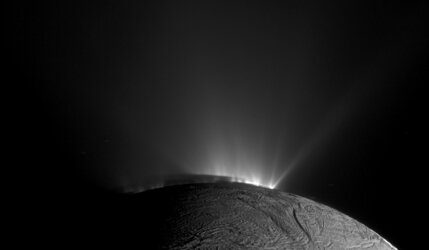Dark-stained Iapetus
This near-true colour view from NASA/ESA/ASI Cassini reveals the colourful and intriguing surface of Saturn's moon Iapetus in unrivaled clarity.
Images were taken with different spectral filters by the Cassini narrow-angle camera on 31 December 2004 and merged to form this composite.
The use of colour on Iapetus is particularly helpful for discriminating between shadows (which appear black) and the intrinsically dark terrain (which appears brownish).
This image shows the northern part of the dark Cassini Regio and the transition zone to a brighter surface at high northern latitudes. Within the transition zone, the surface is stained by roughly north-south trending wispy streaks of dark material.
The absence of an atmosphere on Iapetus means that the material was deposited by some means other than precipitation, such as ballistic placement from impacts occurring elsewhere on Iapetus, or was captured from elsewhere in the Saturn system. Iapetus's north pole is not visible here, nor is any part of the bright trailing hemisphere.
The Cassini-Huygens mission is a co-operative project of NASA, ESA and ASI, the Italian space agency.
Credit: NASA/JPL/Space Science Institute















 Germany
Germany
 Austria
Austria
 Belgium
Belgium
 Denmark
Denmark
 Spain
Spain
 Estonia
Estonia
 Finland
Finland
 France
France
 Greece
Greece
 Hungary
Hungary
 Ireland
Ireland
 Italy
Italy
 Luxembourg
Luxembourg
 Norway
Norway
 The Netherlands
The Netherlands
 Poland
Poland
 Portugal
Portugal
 Czechia
Czechia
 Romania
Romania
 United Kingdom
United Kingdom
 Slovenia
Slovenia
 Sweden
Sweden
 Switzerland
Switzerland































